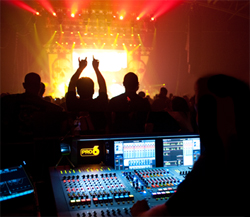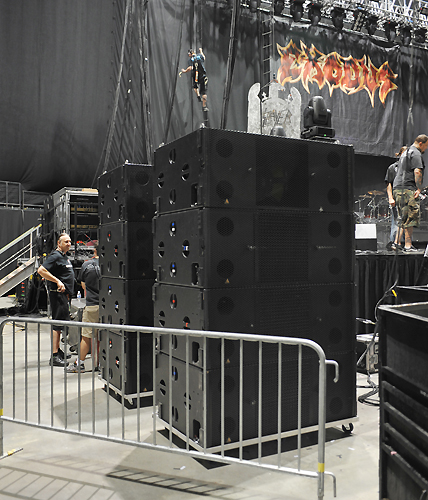
“I use a tremendous amount of sub, but it’s very accurately tuned,” Quinby notes, adding that while the end-fire configuration did the job, he normally uses a cardioid arrangement. “I need a controlled pattern for the sub. We’ve got to focus it away from the stage, or the back wave from the left and right PA ends up meeting directly on our drummer’s seat and he ends up nauseous.”
Way More Detailed
While both Rob Zombie and Slayer offer up high-impact, high-volume shows, Quinby and Lonky’s needs, in terms of low end, were somewhat different. “The number of subs we had was plenty for me,” Lonky says. “Tim wanted to double them, but then he’s all about knocking the rivets out of these arenas.”
Quinby doesn’t disagree. “If I can register seismic activity with a Slayer show then we’re having a good day. That’s what the band wants me to do. That’s what their fans come to see. And I’ve become pretty detailed about it, but I can get way more detailed with more subs.
“We’ve done shows previously with Adamson rigs – the same amount of top end boxes in the air – but with 40 subs,” he continues. “I need a lot of output in order to cut problem frequencies using very narrow cuts, and maximum wattage to get a 60 Hz kick drum that feels like someone is beating you senseless. For what Joel was doing, it was great. For me, they sat on clip.”

The I-Tech amps internal processing handled all loudspeaker crossover, with the exception of the subs, which were crossed over with XTA DP Series processors. Lake Mesa Quad networked processors (with wireless tablet interface) were applied to overall system processing and management.
I-Tech amplifiers also drove the large-scale stage monitoring system, which was comprised of Sound Image (dual-12) wedges, L-Acoustics ARCS loudspeakers for side fill and dB-SUBs (triple-15) for drum fill. The monitoring system was headed by a Yamaha PM5D-RH console manned by Jared Woods, who did double-duty as monitor engineer for both bands.

For lead vocals, Rob Zombie uses a Beta 58A wireless capsule and a Shure wireless system. Beta 58As are also used for background vocals. Lonky mics guitarist John 5’s amps using a Heil Sound PR 31BW, a Shure SM57 and a Shure KSM44. Bassist Piggy D is taken direct.
“I use three different mics on guitar because they all have different tones,” Lonky explains. “I’ll pan them 3 o’clock and 9 o’clock, then put the SM57 up the center. I can pull it back and the left and right become less pronounced, or if I want to go with a big, in your face thing, I can bring the 57 up. I tune the left and right mics a little differently on the EQ to get a layered sound, like there’s not just one guitar playing.”
